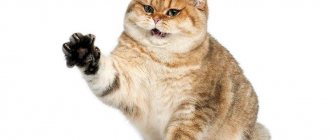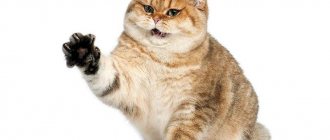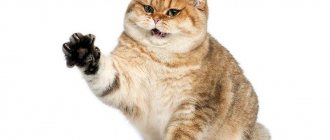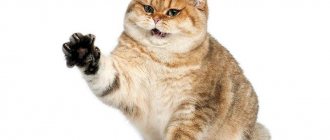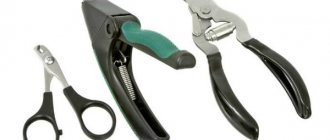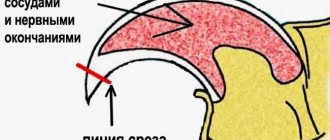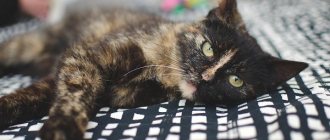For many domestic cats, nail trimming is a must. Growing nails cause discomfort to animals, and if they are not shortened in time, inflammation may begin. However, you need to properly prepare for a cat “manicure” and learn the technique of performing it. Then the procedure will take place with minimal stress and will not cause pain to the cat.
Which animals are not recommended for the procedure?
There is no need to trim the claws of a cat that roams freely outside. She needs her nails to climb trees, hunt and defend herself from other four-legged animals.
Also, the procedure is not performed on kittens under 1 month of age. Their claws are not yet formed. Early cutting negatively affects the structure of the nail plate and leads to delamination.
But already at 2 months the claws are strongly extended, and the kitten begins to scratch. At this time they can already be cut.
Why trim claws
It is necessary to compare all the “Pros” and “Cons” before starting the procedure.
Disadvantages of nail trimming
- Only a few millimeters from the edge can be trimmed. In practice, it is quite difficult to comply with this rule. As a result, the claw is injured, blood appears, and the risk of infection increases. Especially if the cat goes outside.
- The claw is an integral part of the animal's body. This is not a manicure for beauty, but a tool for fighting, overcoming heights, and getting food. Trimmed claws disrupt the cat's normal living conditions. When he is on the street, he will not be able to protect himself; when he tries to climb a fence or tree, he will fall and be injured. Such an incomprehensible situation for him disrupts his psyche. But, even if the cat always remains indoors, injury can also occur, and the likelihood of infection and disruption of the nervous system remains.
- Since the claw contains nerve endings, the procedure is always painful for cats.
- If you cut your hair once, you will have to do it constantly every month.
Positive aspects of nail trimming
- When the animal is constantly indoors, most of its functions disappear - there is no need to fight with other cats, climb trees from dogs, or chase mice, since they provide special food. But along with this, the claws continue to grow. There is simply nowhere to sharpen them. They grow to an uncomfortable size, it becomes uncomfortable for the animal to walk, the claws grow into the skin and peel off. Trimming nails is necessary for the best health of your pet.
- Scratched expensive furniture, chipped carpets, peeled wallpaper - all these are the tricks of cats. But they don’t do it out of malice either – instinct tells them. To avoid all this, the cat needs to have its claws trimmed, but on the condition that the animal does not go outside or does so under the supervision of its owners.
- Due to overly aggressive or playful behavior of cats, small children suffer. To avoid such troubles, cats need to trim their claws.
If you decide to trim your cat’s claws, you need to do it according to the rules, using special equipment.
What tools can you use?
There are special nail clippers for trimming cat claws. It is not recommended to use nail scissors. They are designed for thin and flat nail plates of people. Such cutting tools lead to delamination.
There are several types of nail clippers:
- Blisters - resemble nail scissors, but have blades curved at the ends, designed for cat claws.
- Secateurs are equipped with a spring, which is located between the handles. As a rule, such models have a limiter. It allows you to cut only the desired length.
- Guillotines are similar to cigar scissors. The nail is placed in the hole at the end. When the handles are closed, the blade lowers and cuts the claw. The tool is suitable for cats with thick nail plates.
Each owner chooses the model that is convenient for him to use. The main thing is that it is made of high-quality materials and sharpened.
Additionally, you can buy an electric trimmer that allows you to quickly trim your nails. However, not all cats react calmly to it - the buzzing device scares the animals.
Important. When cutting, the blade of the guillotine nail clipper must move from bottom to top, otherwise the risk of crushing the nail increases. This is especially dangerous for kittens whose claw plates are not yet strong enough.
Cat Nail Trimming Tools
Before telling you what tools are used to trim a cat’s claws, it is worth warning that they are not used under any circumstances: ordinary scissors are not suitable, however, neither is the housewife’s favorite manicure set. As an exception, sometimes only a nail file is used for polishing nails.
Specialized pet stores are not uncommon, as are veterinary pharmacies, so you can safely purchase a variety of cat care supplies there. In such places they will always advise and select convenient tools and even give advice on how to trim a cat’s claws .
What is used for cat manicure:
- a nail clipper, which must be sharp. Dull blades often hit sensitive areas and cause pain. Nail clippers are divided into sickle and guillotine clippers;
- a blood stopper or antiseptic. These medications may come in handy if you hit a sensitive part. Iodine or hydrogen peroxide work great. After cauterization, the wound is sprinkled with baby talcum powder;
- blisters - special scissors that look like manicure scissors, but are designed to resemble a cat’s claw;
- file for polishing;
- Long-haired cat breeds, such as Persians, will need a hair clipper, as fur on the paws interferes with the claw trimming process. If the cat is shy or the sound of the running machine irritates him, then the fur from the paws is cut off by hand using scissors;
- alcohol to disinfect accessories. All nail trimming tools must be sanitized before the procedure begins.
How often is nail trimming done?
The frequency of haircuts depends on the individual characteristics of the cat. For some, it is enough to carry out the procedure once a month, for others – every 2-3 weeks.
As a rule, light-colored nails grow faster. And in cats that prefer active games, partial wear occurs naturally. To determine the exact timing, you just need to carefully observe your pet.
For your information. A cat needs to have its claws trimmed before an exhibition, competition or other important event.
Features of the structure of claws
three types of claw growth based on their structure :
- folded like a cat , with curved ends;
- standardly folded , having an arched shape;
- hare type , with straight growth and sharp tips.
The first two options are typical for service and large breeds , and the third type is most often found in decorative dogs.
The structure of the claws has a direct impact on parameters such as posture, as well as balance and grip on the surface during walking and running.
Important! Improper or untimely implementation of the haircut procedure can cause a number of problems, including the appearance of pathologies of the musculoskeletal system, injuries of varying severity, loss of balance or lameness.
Preparing for the first procedure
To trim a cat's claws with minimal stress, the animal is first accustomed to this procedure. It is better to start doing this in childhood. Kittens adapt to any changes more easily than adults.
For your information. There are cases where adult cats, accustomed to clinging with their claws while jumping, have fallen and been injured due to the fact that their nails were suddenly cut.
Preparations for grooming begin at a time when the cat is not doing anything (not playing, licking itself, eating or sleeping). They take her in their arms and stroke her affectionately.
Then they carefully move to the paws - they try to touch, lightly massage, imitate a haircut. At the same time, they talk to the pet and try to switch its attention to something interesting so that it does not break out.
As a rule, kittens do not like to have their paws touched, so the first 2-3 times they will get irritated and run away. But if you regularly repeat this exercise, the baby will get used to the manipulations. To reinforce the positive associations, he is given a treat at the end.
When the kitten begins to be calm about being touched, they begin to “rehearse” the haircut itself:
- put the pet in the desired position;
- take each paw in turn;
- examine the nails, press on the pads.
If the kitten tolerates all the actions, he is sincerely praised.
Then the pet is introduced to the nail clipper. It is important to show that the tool does not pose any danger. After the animal begins to treat him calmly, you can cut the kitten’s claws for real.
Why does a cat bite its nails?
Sometimes you can witness how cats, like people, bite their nails. Often such actions are perceived as an element of self-care - the cat thus gets rid of the old stratum corneum - the so-called “case”. Or the nail has grown so much that it already causes discomfort and the cat gnaws it. Usually, the listed problems are easily solved by the cat on its own, by grinding its claws on furniture or other surfaces in the house. However, this may not be enough for pets. Here you will need the owner's help to trim your nails. There are also other, more serious reasons for this behavior in cats.
Paying attention to your pet's behavior is the key to its health
The first reason is being in a stressful situation. There can be many reasons for stress in an animal. This includes the appearance of a stranger in the house, a change in the usual environment, be it a move or a trip, and any violent actions towards the cat. At the same time, the animal may not understand the true meaning of actions directed towards it. These types of actions include: taking medications, washing the cat, treating wounds and other similar procedures. The point of these manipulations is to take care of the health of your four-legged pet.
Pets with free access to the street are no strangers to stressful situations - attacks from stray dogs, the chance of getting run over by a car, and simply the possibility of being harmed by people who can harm the animal. If you have not previously observed a cat biting its nails, you should analyze what possible events preceded this.
Step-by-step instruction
A cat's claws consist of a keratinized layer, inside of which there is a pulp - a collection of nerve endings and blood vessels. When trimming, it is important not to touch a sensitive area, otherwise it will be very painful for your pet and blood will come from the wound.
In cats with light-colored claws, the pulp is clearly visible - it looks like a pink, crescent-shaped area. You can point your paw at a bright light or use a flashlight - the picture will be clearer.
It is more difficult to trim the claws of cats with dark pigmentation - you will have to act blindly. In this case, carefully cut off 1-2 mm at a time until the color inside becomes a little lighter - this is the beginning of the pulp.
For your information. Before cutting, remove the hair between the pads so that it does not interfere.
Nail trimming begins when the cat is calm, relaxed and ready to communicate. At this point, the owner should disinfect his hands and nail clippers, prepare cotton pads and antiseptic in case of injury.
Step-by-step instructions for trimming nails at home:
- The owner takes a comfortable position, puts the cat on his lap with his back to himself or lays him on his back. Particularly mobile pets can be wrapped in a terry towel.
- He takes the paw in his hand and presses on the pad to expose the claw.
- He brings the nail clipper to his paw. If the cat does not show concern, clicks it. In case of anxiety, he strokes and calms the pet, after which he repeats the manipulation.
- Now quickly and confidently sets the nail cutter 1-2 mm to the pulp and trims the claw so that the edge remains sharp. If you cut the platinum at the wrong angle, you will be more likely to hit the pulp.
- At the end, the cuts are rounded off with a nail file, giving a natural shape. In the future, you will be able to trim your claws less frequently if you regularly trim the overgrown areas.
If you trim your cat's nails correctly, your cat will not experience any discomfort. In fact, many animals struggle and hiss not because of pain, but because they are scared.
In order not to overwork the cat, the haircut is carried out in several passes. For example, one paw is treated daily.
Nail clipper for dogs: selection criteria and rules of use
When a dog is cramped in an apartment or spends a lot of time in a pen with a wooden covering, rushes along paths with pliable soil, or sits in the arms of the owner, the owner should carefully monitor the pet’s paws. It is especially necessary to pay attention to the enlargement of the claws, which grow on your four-legged friend throughout his life. Growing and becoming excessively long, they cause discomfort to the pet and can lead to muscle atrophy and even joint deformation. A pet can get caught in an overgrown claw, which can lead to injury. In other words, a nail clipper is not only a convenient thing, but also simply necessary.
This is interesting: Katya Guseva and Philip Kirkorov
What to do if the animal is not given
To trim the claws of cats that categorically refuse this procedure, they use fixing overalls. They provide access to all limbs, but do not allow the pet to move freely.
At first, it is advisable to carry out the haircut with an assistant who will hold the animal. If the cat meows loudly and struggles, take a break. Let her rest and calm down for a while, then you can try again.
Important. You should not swear or shout at a cat if it resists while trimming its claws. Aggression from the owner will only frighten her. In the future, the pet will try by all means to avoid the unpleasant procedure.
First aid for injuries
Even experienced owners may experience situations where the pruning procedure becomes stressful. This could be due to a huge number of factors, ranging from a dull instrument to a sharp sound outside the window that frightened the pet.
It is important to remain calm and clearly understand the algorithm of actions in the event of an injury.
Pulp trauma
If the pruning is done too short, there is a high risk of damaging a large number of blood vessels. In this case, heavy bleeding and sharp pain occur;
This is interesting: Skin Mites on the Face
It is the owner's job to stop the bleeding and calm the dog. Try to distract your pet. You should not shout at him, because the animal is in severe pain;
Using brilliant green, an alcohol solution of iodine, or other alcohol-containing antiseptics will only increase the pain. Therefore, many breeders prefer to treat open wounds with antiseptic powder.
You might find our article useful: Home veterinary first aid kit for dogs
This is important: If an injury occurs, and the first aid kit does not have the necessary medications, then experts advise stopping the bleeding with the help of flour.
Claw detonation
This situation arises in case of uncertain actions of the owner. Slow squeezing of the nail clipper by the owner in combination with a sharp jerk of the paw at the moment of manipulation can lead to disastrous results.
As a result, the claw becomes caught in the instrument and the skin and soft tissues rupture. The owner should:
- Remember that this is very painful for your four-legged pet. Therefore, he will try to break free and run away;
- The injured limb should be bandaged with gauze or a tourniquet in the metatarsal area; Raise the limb upward to stop bleeding;
- Apply cold to the injured paw. This could be an ice pack, food or fruit from the freezer;
- Open lesions should be treated with lidocaine. In its absence, this drug can be replaced with novocaine;
- If the wound is too large or the gap needs to be stitched, you should immediately seek help from a veterinarian.
This is important: before you remove frozen food from the freezer, place it in a bag and then wrap it in a towel or cloth. This will help avoid hypothermia. Also, you should not hold the cold on the injured limb for long to avoid frostbite.
The owner should remember that if an injury occurs, the dog must be left alone and not continue the nail trimming procedure for a period of 5-10 days.
Benefits and importance of the procedure
During a short walk, the dog's claws do not wear down so much that they do not grow in and cause pain to the animal. Long legs can break, causing pain, and they also interfere with the dog's walking.
- Nails that are too long can cause joint deformities.
- The rudimentary claw curls and digs into the paw, causing pain.
- While playing with the owner or children, the dog can hurt painfully with its long claws.
- The dog may involuntarily scratch furniture or things.
- Therefore, all pet dogs need to have their nails trimmed.
An exception to this rule may be dogs that live or spend most of their time outdoors. That is, animals that have the ability to grind their claws on the hard surface of concrete or asphalt.
Cutting nails at home
The instrument should be disinfected before the procedure. It's a good idea if the dog has the opportunity to sniff the clipping tool. The dog's nails should be disinfected to avoid infection if the animal is accidentally injured.
For the same purposes, a hemostatic agent should be on hand. First you need to determine the length of the cut; you should not rush. It is better to cut off the claw little by little so as not to damage the vessel.
By cutting off only the curved part of the nail, it is impossible to damage the vessel. If the dog begins to get nervous during the procedure, it is better to let it go and postpone the procedure until the next day. How often should you cut your dog's nails? Your pet's nails should be cut at least once every three to four weeks.
